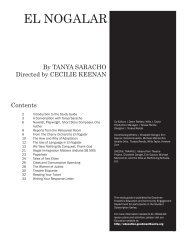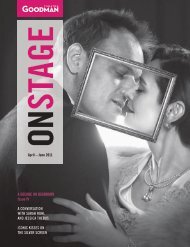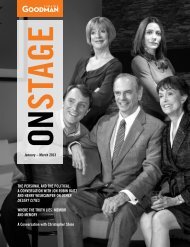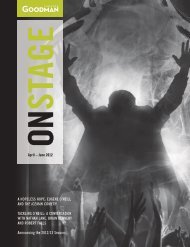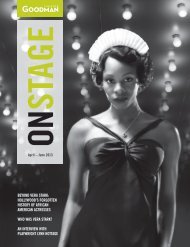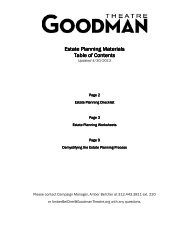A True History of the Johnstown Flood Study - Goodman Theatre
A True History of the Johnstown Flood Study - Goodman Theatre
A True History of the Johnstown Flood Study - Goodman Theatre
You also want an ePaper? Increase the reach of your titles
YUMPU automatically turns print PDFs into web optimized ePapers that Google loves.
Introduction to <strong>the</strong> <strong>Study</strong> Guide<br />
BY WILLA J. TAYLOR, DIRECTOR OF EDUCATION AND COMMUNITY ENGAGEMENT<br />
A <strong>True</strong> <strong>History</strong> <strong>of</strong> <strong>the</strong> <strong>Johnstown</strong> <strong>Flood</strong>, Rebecca Gilman’s<br />
wonderful new play, looks at an event that destroyed<br />
a Pennsylvania city in 1889, but <strong>the</strong> parallels to New<br />
Orleans and <strong>the</strong> devastation unleashed by Hurricane<br />
Katrina five years ago are frightening.<br />
I spent a lot <strong>of</strong> my childhood visiting relatives in<br />
Louisiana and <strong>the</strong> Gulf Region. I rooted for <strong>the</strong> Saints<br />
long before <strong>the</strong>y were ever good enough for a Super<br />
Bowl. And I learned <strong>the</strong> secret <strong>of</strong> black roux and gumbo<br />
in my Aunt CC’s kitchen. When Katrina hit, I quit my job<br />
and went to New Orleans to help rebuild <strong>the</strong> city. What I<br />
saw was horrific. The destruction to <strong>the</strong> city I loved was<br />
tragic – two-story houses collapsed like accordions;<br />
personal possessions strewn on empty lots, <strong>the</strong> last<br />
vestiges <strong>of</strong> what had been someone’s home; <strong>the</strong><br />
ubiquitous red X’s on dilapidated structures, indications<br />
that buildings had been searched and whe<strong>the</strong>r bodies<br />
had been found. But more than <strong>the</strong> physical decimation<br />
and <strong>the</strong> stench <strong>of</strong> decay and death was <strong>the</strong> brutal<br />
realization that in 2005 – as in 1889 in <strong>Johnstown</strong> -<br />
class and race were still determining factors in who<br />
was expendable, what was considered valuable and<br />
what could be tossed aside and forgotten. In <strong>Johnstown</strong><br />
and in New Orleans, it was <strong>the</strong> hubris <strong>of</strong> those with<br />
resources who ignored <strong>the</strong> dangers to those without that<br />
contributed to <strong>the</strong> devastation and destruction <strong>of</strong> life and<br />
culture.<br />
Now <strong>the</strong>re is Haiti.<br />
And Chile.<br />
And Turkey.<br />
It’s been more than a century since <strong>the</strong> <strong>Johnstown</strong> flood<br />
washed away a town and exposed <strong>the</strong> economic divide<br />
between wealthy industrialists and <strong>the</strong> immigrants who<br />
worked in <strong>the</strong>ir factories. In August, it will be five years<br />
since Katrina blew down <strong>the</strong> levees and exposed <strong>the</strong><br />
ugliness <strong>of</strong> class and racial disparity to a much wider<br />
audience.<br />
There are some lessons we seem unable to learn.<br />
New Orleans photo.<br />
A scene from <strong>the</strong> Lower Ninth Ward in New Orleans after Hurricane Katrina. Photo courtesy <strong>of</strong> Willa J. Taylor.<br />
2



